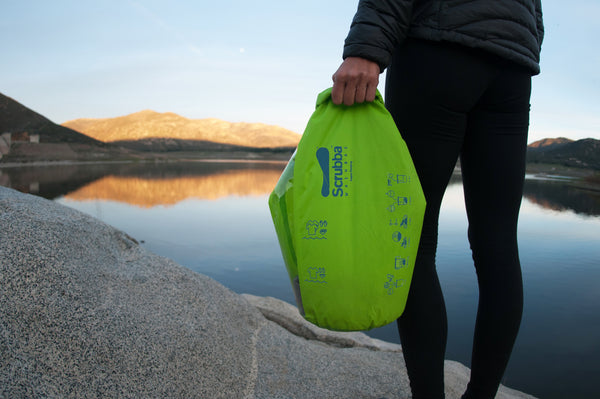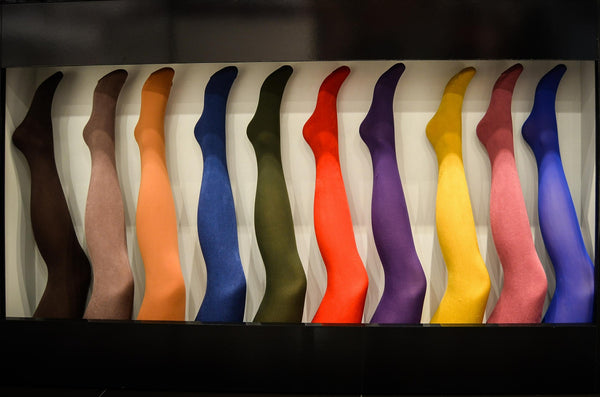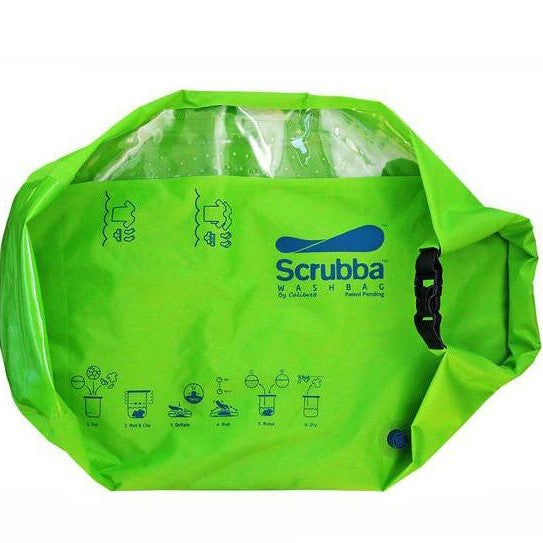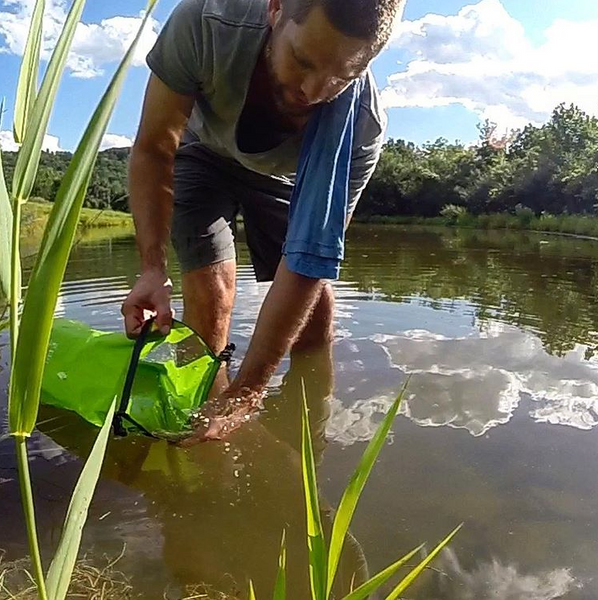Scrubbing Up Well: The Materials that Make the Famous Scrubba Wash Bag


There's beauty in simplicity.
When Managing Director, Ash Newland, set his mind to combating the difficulty of efficiently completing laundry on-the-go, he knew only the best idea compatible with tempestuous outdoor environments, would do. Determined to test his vision during a trip to Mt Kilimanjaro in 2010, Newland began to experiment by blending the proven effectiveness of old fashioned washboards with modern materials and manufacturing methods. It is to this combination of old and new that the Scrubba wash bag continues to pay homage as it evolves with rapidly changing technologies and global markets.
By stripping back the bells and whistles, we've managed to create a back to basics product that not only prioritises practicality and efficiency over theatrics, but that also directly solves the problem of washing clothes on-the-go. Although we’ll always be eager to evolve and develop the Scrubba wash bag in accordance with our supporter's needs, we promise that the wash bag will never lose the core features of lightness, portability, and durability that underlie the entire Scrubba philosophy.

What is the Scrubba wash bag?
Despite its basic appearance and straightforward purpose, a lot of materials go into helping our wash bag scrub up so well!
The Scrubba wash bag is made from a 40 denier nylon fabric with a polyurethane coating. These materials, in conjunction with high frequency welding techniques applied during the manufacturing process, allow for a wash bag that is simultaneously durable and lightweight, creating the perfect device for travel and the outdoors.
If some of the above materials sound unfamiliar, don't fret! We’re here to deconstruct the gobbledegook by shedding some light on exactly what goes into our Scrubba wash bag so you can better understand how over 100,000 travellers, campers, and outdoor enthusiasts have benefited since its launch back in 2012.
What is nylon?
Nylon has a long history fraught with excitement. Synthesized in a DuPont Chemicals laboratory in the 1930s, it soon became available to the public in the form of stockings. It may seem strange from today's perspective, but the new synthetic was met with near unprecedented levels of demand bolstered by the high cost of silk in the post-Depression era, escalating an already booming fashion trend. Although nylon underwent a near complete move to military production during the period of the Second World War – during which time the popularity of stockings and their relative unavailability led to a burgeoning black market – it returned to commercial shelves shortly after. This was met with both unthinkably long lines (in 1946, 40,000 women lined up in Pittsburgh in an effort to compete for 13,000 pairs of stockings) and a desperation that often manifested itself in episodes of violence that have come to be known as the ‘nylon riots’.
Today, nylon is an indispensable material used in everything from outdoor gear to medical implants, revealing a plethora of useful applications that eclipses even its enthralling beginnings. Its endurance and pervasiveness across all industries truly underscores the benefits it has bestowed upon the manufacturing and commercial worlds, and it is therefore unlikely to be toppled from its throne any time soon!

What does 40 denier mean?
As anyone familiar with stockings or tights will likely be aware, denier is a unit of measurement that is used to determine the fibre thickness of the individual threads or filaments that are used in textiles. The higher the denier count, the thicker and more durable the fabric typically is. That is not, however, to dismiss lower denier counts, as these products typically benefit from a sheer and silky quality that is both softer and lighter in comparison to higher denier fabrics.
The Scrubba wash bag may seem dangerously light and thin at first glance, but don’t be fooled! Indeed, by opting for a 40 denier nylon fabric, we have ensured that the Scrubba wash bag maintains a careful balance between strength for maximum durability and lightness for maximum portability – a firm requirement of our entire product range. Built not only to withstand the turmoils of the roughest adventures, but also to fit easily into even the smallest bag or pocket thanks to its mere 142g (~5oz) weight, the Scrubba wash bag can truly be taken just about anywhere to deliver a fast, efficient machine-quality wash, enabling you to travel clean, light and free like never before.
What is thermoplastic polyurethane (TPU)?
Polyurethane is one of those magical substances that helps improve many of the products we use every day – even if most of us don’t realise it! Indeed, according to the Essential Chemical Industry, “No other plastic allows itself to be made to measure in the same way as a polyurethane. Foams can be flexible or rigid, resistant to cold or particularly kind to skin.” Wildly adaptable, this nifty substance can even occur as a spray or coating, adding vital strength in the form of defence against corrosion and abrasion. TPU has been used in the textile industry for many years, where it has achieved proven results and is particularly admired for its outstanding abrasion resistance.
In addition to its coating, the Scrubba wash bag’s clear window, washboard, and grip surface are made from TPU. This ensures not only good microbial, chemical, and hydrolysis (water damage) resistance, but also good low temperature flexibility, ensuring your wash bag is prepared to overcome just about any challenge your journey might throw at it.

What is high frequency welding (HFW)?
High frequency welding refers to the process of fusing materials through the application of a radio frequency energy. The process is favoured because it typically results in a weld that is just as strong as the original materials. Furthermore, because high frequency welds are produced only by the original material without the use of adhesives or by-products, they acquire a cleaner, smoother finish, resulting not only in a more aesthetically pleasing product, but also a strong, leak-proof seal.
By utilising HFW during manufacture, we have been able to produce a durable, yet lightweight product that is ideal for washing clothes and protecting gear from moisture.
Getting the most out of your wash bag:
The Scrubba wash bag has been built to last, but like everything in life it tends to give more back if it’s treated with a little respect. Here are some small things you can do to look after your Scrubba wash bag and maximise its life.
Rinse and turn the Scrubba wash bag inside-out to dry after each use:
Air drying the inside of the bag will help it last longer and make it more hygienic, bolstering the defences already provided by the microbial and hydrolysis resistant TPU coating. Simply turn your bag inside out and use the strap to fasten it around a shower head or tree branch, enabling it to drip dry in a short period of time.
Avoid exposure to heat, sunlight, and harsh chemicals:
Exposure to sunlight or temperatures over 50°C (122°F) can damage the inner and outer coatings of the Scrubba wash bag, so where possible you should endeavour to dry your bag in the shade. Finally, avoid using bleach and other harsh chemicals in your wash bag, as these can negatively impact the waterproof lining.
Take care when washing clothes with zips, buckles or other hard features:
Such items can result in small fabric tears or punctures, especially if vigorous washing is undertaken. Wrapping the clothes to cover zips, buckles, and other hard features is therefore recommended in order to minimise potential damage to the bag.
Avoid sharp or abrasive surfaces:
The Scrubba wash bag has been designed for the rough terrain of the Great Outdoors. However, as such terrain can accelerate wear and tear, you should always select the least abrasive surface available for the washing process. As with all waterproof products, avoiding sharp objects such as rocks and twigs will reduce the likelihood of punctures.
Designed and constantly redeveloped by travellers, for travellers, the Scrubba wash bag has been used and loved by outdoor enthusiasts all over the globe. One of the only items you can add to your pack in order to reduce its overall weight, the wash bag is ideal for use both indoors and outdoors, from cruise ships and hotel rooms to camp sites and rugged wilderness. Now you can carry less, save time and money, and travel clean, light and free, no matter where your journey takes you.
Check it out and start your clean, light and free journey, today.
Further Reading:
http://www.belsonic-machines.com/index.php/en/operation-principals/principles-of-high-frequency-welding
https://www.chemheritage.org/distillations/magazine/nylon-a-revolution-in-textiles
http://www.essentialchemicalindustry.org/polymers/polyurethane.html
http://www.standardfiber.com/materials/bedding-basics/about-denier/
http://www.zemat.com/en/information/technology/high-frequency-welding





